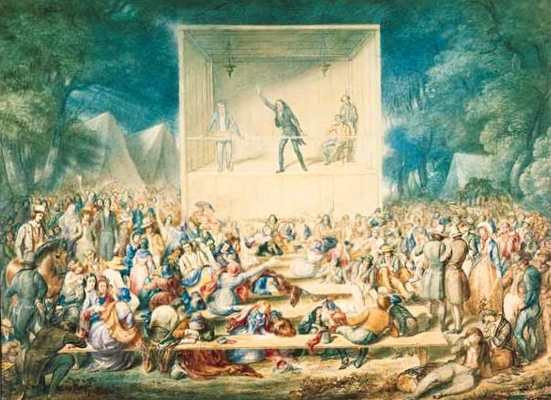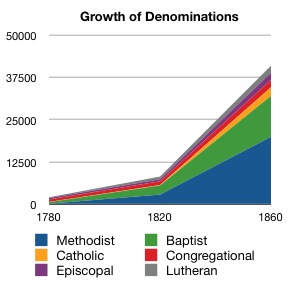Methodist Revival Meeting during the Second Great Awakening, 1839

Topics on the Page
The Second Great Awakening
The Temperance Movement
The Women's Movement
 Historical Biography page: Dorothea Dix, 19th Century Mental Health Reformer
Historical Biography page: Dorothea Dix, 19th Century Mental Health Reformer
 CROSS-LINKS:
CROSS-LINKS:
The Abolitionist Movement
Women of the Abolitionist Movement
The increase in the number of Protestant denominations
The influence of these trends on the reaction of Protestants to the growth of Catholic immigration
 Cross-Links:
Cross-Links:
Political Parties in U.S. History
AP US History: Concept 4.1
Women's Suffrage Movement Before the Civil War
Focus Question: What were the important religious and reform movements that shaped antebellum America?

|
PAGE SUMMARY
The term Antebellum means “before war” in Latin, and this period in the United States was before the Civil War- the country became polarized, with the South only wanting to enact policies that were beneficial to their people and fiercely defending the use of slavery, while the North attempted to unite the nation with policies that were beneficial to large portions of the nation, and mostly supported abolition.
The Second Great Awakening was a gigantic social movement that occurred during this time. A massive rise in particularly Christian denominations helped fuel the feelings of sectionalism. At the same time, religion became a primary influence in many people's lives, and abolitionists attempted to use this to their advantage.
The Temperance Movement also spread during this time and also largely in part due to the Second Great Awakening. Many denominations established during this time were vehemently anti-alcohol, and propaganda from interest groups and the government was common. The Women’s Movement also picked up steam following the Seneca Falls Convention in 1848, many of whom also advocated for the prohibition of alcohol (Page Summary by Ashley Blatt, April 2022).
|
 Click here to rent/buy a documentary on the First Freedom: The Fight for Religious Liberty
Click here to rent/buy a documentary on the First Freedom: The Fight for Religious Liberty
Click here for a link to articles about antislavery, temperance reform, and the second great awakening.
This is a great link that has many different resources besides just articles.
 For an contemporary perspective, see Religious Freedom Restoration Act of 1993
For an contemporary perspective, see Religious Freedom Restoration Act of 1993
The Second Great Awakening
The period before the Civil War in the U.S. is commonly referred to as Antebellum which literally means “before war” in Latin.
- It was during this period that the country became more polarized, leading to the outbreak of the Civil War.
- The term sectionalism is also used to describe what was going on in the country at the time.
- Slide Show on the rise of sectionalism in the U.S.
- Southern states were increasingly going after policies that would only benefit a small portion of the country, whereas Northern states favored policies that would help to unite the nation and directly impact the country as a whole.
- The South believed strongly in state’s rights, while the North saw a need for a unified union in order for the nation to succeed.
- Religion played a key role for during this period, and many people used religion and religious teachings to be motivation for making societal changes.
- In addition to the abolitionist movement, women's rights and the temperance movement were also present in the antebellum years.
Religion was a major component of the antebellum period. Christianity was becoming more dominant, and Christian beliefs were becoming law.
- The Second Great Awakening was a major social movement of the 19th century.
- Also present was an increasing number of Protestant denominations and Catholic immigrants which all also lead to split sides and feelings of sectionalism.
 The Age of Reason by Thomas Paine was instrumental in cultivating debate leading to and during the Second Great Awakening.
The Age of Reason by Thomas Paine was instrumental in cultivating debate leading to and during the Second Great Awakening.
Lecture given by Charles Finney in 1835 which discussing the religious revival.

- Khan Academy video on the Second Great Awakening.
- Click here for an AP US History simplified video about the Second Great Awakening.
In the early portion of the 19th century there was a great revival of religion in the states. Many new denominations of Protestantism emerged along with several other sects of Christianity.
- The Baptists, Mormons, and Methodists all experienced a revival on a larger scale than other denominations. Evangelical Christians experienced the largest growth of all and worked hard to spread their religion and convert others.
- During this time religion became so important that it was able to influence many people into either changing their beliefs toward equality or establishing them.
- Abolitionism was able to spread through this religious lens, as people were beginning to see the inherent evils in slavery.
JSTOR article on Young Women and the Second Great Awakening in New England.
Timelines of important religious events and figures in U.S. History.

Key questions on the Second Great Awakening and lesson plan ideas.
Document Based Activity (or DBQ) on the Second Great Awakening.
Click here for a collection of primary source documents on the Second Great Awakening.
 One of the important effects of the Second Great Awakening was:
One of the important effects of the Second Great Awakening was:
a) the weakening of the Methodist Protestant denomination
b) the growth of reform movements that addressed issues in many areas of United States society
c) a decrease in the participation of women and African Americans in religious revivals
d) the unification of various Protestant denominations in Eastern states
Correct Answer: B (2010 National Assessment of Educational Progress; 64 percent of 12th graders answered this question correctly)
Other Reform Movements
Text on the image to the right reads: Step 1: A glass with a friend. Step 2: A glass to keep the cold out. Step 3: A glass too much. Step 4: Drunk and riotous. Step 5: The summit attained. Jolly companions, a confirmed drunkard. Step 6: Poverty and Disease. Step 7: Forsaken by Friends. Step 8: Desperation and crime. Step 9: Death by suicide
 |
| The Drunkard's Progress, a Nathaniel Currier lithograph supporting the Temperance Movement, 1846 |
The Temperance Movement
Introduction to Temperance Reform in the Early 19th Century
Click here for a link to primary sources and a teaching guide on women's involvement in the temperance movement.
Ultimately led to the Prohibition Era
Video: History of Prohibition: Why it Failed
The Women's Movement
The Women’s Movement also began to pick up a lot of momentum during this period and along with that was the Temperance Movement.
- Women played large role in the Temperance Movement, saw it as their moral and religious duty as wives and mothers
The Seneca Falls Convention was a meeting from July 19 to July 20, 1848. Participants met to discuss the rights of Women within the United States. It was the first women's convention.
- During the meeting that Elizabeth Cady Stanton authored the Declaration of Sentiments which discusses the issues and reservations that women had during the period. Stanton modeled it after the Declaration of Independence.
- This was all happening from about 1800-1830, and as we now know, these new social ideas created a split that was already brewing between the states.
- Other notable reform movements included a new focus on public schools and mental illness asylums under the leadership of Horace Mann and Dorothea Dix.
- Crash Course on the 19th Century Women's Movements.
- Crash Course on Woman's Suffrage.
New York Historical Society: Women in the Antebellum
Abolitionism
The main focus in terms of the Civil War was the debate over slavery. The Second Great Awakening opened up a lot of eyes towards all the hardships and negatives that go along with slavery. They saw how unjust and morally disgusting the act was and religion helped “fuel this fire.” Those looking into religion for advice saw that this was not okay and soon abolitionists sprung up all over the young nation. Changes were in store and because of this revival of religion, those changes were going to be positive for the nation.
Click here for a article about the connection between the abolitionist movement and the women's movement.
Growth in Protestant Denominations

The Second Great Awakening, as described above, influenced many people to distinguish their beliefs, if different, from the major forms of Christianity that were present.
In turn, during the years leading up to the Civil War, many new sects of Protestantism began to emerge all over the country.
Also, within the old Protestant denominations, splits were occurring. The issue of slavery, was of course, the main reason for the splits.
Within each denomination people held opposing beliefs leading to intense polarization even between people with very similar religious beliefs.
There were many new denominations that emerged and due to their differing beliefs they were a source for a lot of religious tension that was shaping antebellum America.
Click here Timeline: Faith in America to understand how religious ideas shaped America's public life
Here is a breakdown of the impacts of the Second Great Awakening on different religions.
Protestant Reaction to the Growth of Catholic Immigration
Catholic immigration also played a large role in the shaping of attitudes during this antebellum period.
- Catholics were immigrating from all over Europe, bust mostly from Ireland, to the U.S. and this was causing many Protestants in the country to take notice and to start aiming their efforts away from slavery and towards what they saw as the problem of Catholic immigration.
- To Protestants nationwide, Catholics seemed to be inferior people. They were not fit to enjoy liberty like the citizens of the country were. The Catholics were mostly working-class families so their presence also meant far less jobs for everyone else
- Immigration has always been a concern for some group in the U.S. During this period it took special importance because it further polarized the nation, now in a new manner. The Catholic immigrants were constantly entering the country and the Protestants here were going to try and make it so they couldn’t and so they couldn’t in turn influence any policies here in the U.S.
Know-Nothing Party Flag, 1850

 The Know-Nothing Party
The Know-Nothing Party
Go here for a brief background on the Know-Nothing Party (American Party)
 Sheet music for the Know-Nothing Polka
Sheet music for the Know-Nothing Polka
Video on Nativism and the Know-Nothing Party
Comments (0)
You don't have permission to comment on this page.